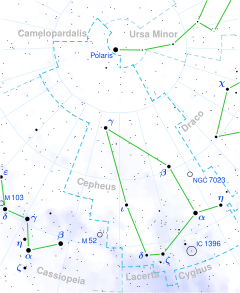RW Cephei
| Observation data Epoch J2000.0 Equinox J2000.0 |
|
|---|---|
| Constellation | Cepheus |
| Right ascension | 22h 23m 07.01657s |
| Declination | +55° 57′ 47.6262″ |
| Apparent magnitude (V) | +6.65(6.0 - 7.3) |
| Characteristics | |
| Spectral type | K2 0-Ia(G8 - M2Ia-0) |
| Apparent magnitude (K) | 1.88 |
| U−B color index | 2.38 |
| B−V color index | 2.22 |
| Variable type | SRd |
| Astrometry | |
| Radial velocity (Rv) | -56.00 km/s |
| Proper motion (μ) |
RA: -2.74 mas/yr Dec.: -2.66 mas/yr |
| Parallax (π) | 0.81 ± 0.36mas |
| Distance | 3,500pc |
| Absolute magnitude (MV) | -9.4 |
| Details | |
| Radius | 1,535 R☉ |
| Luminosity | 550,000 L☉ |
| Surface gravity (log g) | 0.2 cgs |
| Temperature | 4,015 K |
| Other designations | |
| Database references | |
| SIMBAD | data |
RW Cephei is an orange hypergiant star in the constellation Cepheus. One of the largest stars known, RW Cephei is estimated at 1,535 solar radii (1.068×109 km; 7.14 au), which is larger than the orbit of Jupiter.
RW Cephei is also a semi-regular variable star of type SRd, meaning that it is a slowly varying yellow giant or supergiant. The visual magnitude range is from 6.0 to 7.3, while the photographic range is from 8.6 - 10.7. The General Catalogue of Variable Stars gives a period of approximately 346 days, but other studies suggest different periods and certainly no strong periodicity.
The spectral has been classified as early as G8 and as late as M2, but it isn't clear that there has been actual variation. In the first MK spectral atlas, it was listed M0:Ia. RW Cep was later listed as the standard star for spectral type G8 Ia, then as the standard for K0 0-Ia. Based on the same spectra it was adjusted to the standard star for type K2 0-Ia. Molecular bands characteristic of M-class stars are seen in infrared spectra, but not always in optical spectra. The temperature is equally uncertain, with contradictory excitation strengths in the spectrum. A simple colour correlation temperature fit gives temperatures around 3,750 K, while a full spectrum fit give temperatures of 5,000 K.
The distance to RW Cephei has been estimated on the basis of its spectroscopic luminosity and is assumed to be a member of the Cepheus OB1 association at 3,500 parsecs. This is several times further than the distance implied by the Hipparcos parallax, although the apparent diameter of the star is larger than the measured parallax and variable.
The temperature intermediate between the red supergiants and yellow hypergiants, and itself varying considerably, has led to it being variously considered as a red hypergiant or or yellow hypergiant.
...
Wikipedia

